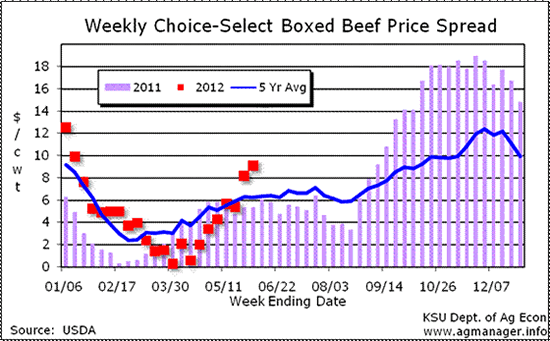
Know Your Cattle, Grid Conditions
Commodity cattle are priced by weight class, sex or average carcass grade, but some are worth a lot more or less. Indeed, some producers carve out a reputation, a kind of brand for their consistently high-quality cattle akin to that of Mercedes-Benz®, Apple® or Rolex®.
Pete Anderson, Ag Knowledge Services, says owners of those better cattle should earn premiums, but producing them is just the first step on the way to capturing value.
"Grid marketing of fed cattle is one way to get paid a premium for producing something that is superior to the average," he notes in a new white paper. Understanding grid marketing: How quality grades and grid conditions affect carcass value is available with its several tables at www.cabpartners.com/news/research.php.

Pete Anderson
The subject may seem "a little mysterious and risky to some, especially feeder cattle producers who are new to retained ownership or only market cattle once or twice a year," Anderson says. It helps to know how grids work and how your finished cattle will perform.
The Choice-Select spread is a key to many premiums and discounts, published daily by USDA and based on sales of primal cuts. On Feb. 15, 2012, for example, the $5.11-per-hundredweight (cwt.) spread came from the range of a $19.95-per-cwt. Choice premium on loins to a Choice discount (-$3.40 per cwt.) for the short plate (see Choice-Select spread chart in whitepaper noted above).
In 2011, a particularly volatile year, the spread ranged from near $0 to more than $18 per cwt., with exaggerated seasonality. Typical seasonal supply factors are higher grades in the winter, lighter carcasses in spring and fewer finished cattle in summer. On the demand side, the grilling season supports steaks and burgers while the fall and winter holidays focus on roasts from the chuck and round. The economy, exports and decisions of large companies are nonseasonal influences, Anderson adds.
The higher the Choice-Select spread, the more premium for quality cattle. "But with grid pricing, what looks like simple math is often not so simple," he says. Mastering the math means figuring in a few more factors.
| Table 1: Premium and discount grades | ||||
| Choice & up
|
Discount QG
|
CAB
|
Prime
|
Quality adj., $/cwt.
|
| 15% | 20% | 1.5% | 0.1% | -6.52 |
| 25% | 12% | 3.5% | 0.2% | -4.27 |
| 35% | 7% | 6.3% | 0.3% | -2.36 |
| 45% | 4% | 9.9% | 0.6% | -0.63 |
| 55% | 3% | 14.3% | 1.0% | 1.03 |
| 65% | 2% | 19.5% | 1.9% | 2.70 |
| 75% | 1% | 25.5% | 3.4% | 4.45 |
| 85% | 1% | 32.3% | 6.1% | 6.40 |
| 95% | 0% | 39.9% | 11.0% | 8.72 |
"The first of these is the percentage Choice requirement (Choice base) required to get par value," Anderson explains. Each grid publishes its Choice base under terms and conditions; sometimes it's a fixed number, but more often it is a moving target like a plant average. Either way, as the hurdle required for par moves higher, all cattle are worth less money above average. "That's because premiums are generated not by the absolute number of Choice cattle, but by the amount by which your cattle clear the hurdle set by the grid," he says (see box at bottom).
Beyond Choice and Select, cattle that grade USDA Prime or qualify for Certified Angus Beef® (CAB®) or other branded programs receive premium prices, and those can be substantial, Anderson says. For example, if 40% of your cattle make CAB at $4 per cwt. more, it amounts to another $12.80 on the pen average, figuring 800-pound (lb.) carcass weights. Prime premiums can run much higher, but even at $15 per cwt., your 800-lb. carcasses grading 20% Prime add $24 to the per-head pen average.
Heavily discounted quality grades can be a problem in some sets of cattle. USDA Standard grade beef has almost no marbling, and its likely unsatisfactory eating experience brings the discount. Table 1 shows an example of how low- or high-grading cattle could compare in premiums and discounts, and the impact on cattle value. In this case, cattle grading 50% Choice would bring the average market price, Anderson notes.
"Remember, it is not enough to create cattle with high value," he says. "You need to find a way to capture that value and put it in your pocket."













